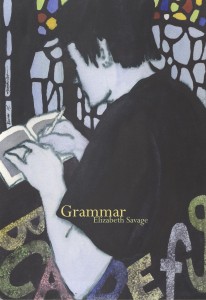Book Review

In Elizabeth Savage’s Grammar, “a common noun” becomes “both leaves / and flowers,” “that tract of green / we tread upon.” Language retains a transformative power as its rules, its limitations, and its possibilities are reinscribed in even the most commonplace exchanges. Presented in the guise of a textbook, complete with entries for “past tense,” “a participle phrase,” and “correlative conjunctions,” Savage’s innovative collection offers instruction not in the formal qualities of language, but rather, in the ways that individuals have negotiated the structures of communication. At turns beautiful and disconcerting, Grammar presents us with a thought-provoking portrayal of language as it is transfigured by our usage, offering readers a graceful matching of form and content all the while.
With that in mind, Savage frequently invokes the rhetoric of pedagogy, while at the same time problematizing these discourses through her choice of poetic imagery. Consider the entry for “Em Dash”:
To make a gap—scatter—the line
Pry apart—the words—that caused it
In absence—abstinence—
Shoulders—the abyss—hinged—
Here Savage pairs the format, tone, and structure of a dictionary definition with images of transience—such as, “the abyss—hinged,” “words” as they are “pried apart,” etc. By doing so, the poet suggests the difficulty of instruction within a linguistic terrain that is constantly shifting. A rule, once articulated, has already been broken and renegotiated, its terms redefined. “Em Dash,” like many other pieces in the collection, offers thoughtful commentary on the philosophical questions associated with language, while at the same time remaining grounded in tangible and visually arresting imagery.
Along these lines, Savage frequently invokes images of the natural world, drawing a thought-provoking comparison between “wind,” “orchards,” “flowers” and the organic qualities inherent in language as it changes shape, withers, and blossoms. Savage writes, for example:
the empty schoolroom
chopped apart
one slender tree
bought the farm
killed the bear
walked the cabin
ceiling raised
beyond repair
Savage reveals grammar, its rules, and its conventions as being as artificial as a “cabin” built in a clearing. In many ways, she implies that language, like the wilderness depicted in the poem, cannot be contained by the structures we design and then impose upon the world around us. Language, like the natural world, unfolds according to its own rhythms, its own seasons. Indeed, Savage gestures at the ways in which the organic nature of grammar, and its inherent “wilderness,” seems at odds with our attempts to impose order, to gain control over it. This piece, like many others in the collection, addresses abstract questions about language with subtlety and grace, offering compelling insights about communication that are neither didactic nor heavy handed.
Lastly, Grammar adeptly and artfully calls our attention to the ways in which language is historically situated, suggesting the impossibility of articulating fixed rules associated with its usage. Throughout the collection, Savage’s words appear as though they are burdened with the past, sedimented with forgotten beliefs, ideologies, and values that escape our awareness but still govern the structures of communication. She writes in a piece entitled “Use the Hyphen”:
To stitch from the age
of inheritance
to the fruits of ninety-nine
left-justified epoxy
wounded majesty
known by its proxy
In this piece, Savage posits language being “stitched” together as words are culled from disparate historical moments and presented as a coherent whole, a language system. She gestures at the problems associated with treating language in the formalistic manner that grammar instruction does, as these rules exist in an artificial, and often ahistorical, space. For Savage, language instead represents a synthesis of past, present, and future as multiple historical moments are made to coexist within the same rhetorical space. This notion of language as a melding of various moments in history is enacted in the form of the poem itself. By pairing words like “left-justified proxy,” which seem as though they were extracted from bureaucratic discourse, with such arcane phrases as “the age / of inheritance” and “wounded majesty,” Savage ultimately suggests the ways in which the past is renegotiated through our use of language. Although the historical phenomena in the poem are “known by proxy,” they are unmade through our constant “stitching” together of “the ages.” Our linguistic “inheritance” becomes increasingly complex as it is made, unmade, and renegotiated. In this sense, language becomes an incredible source of agency for the individual historical agent. Yet these qualities, and the great possibilities inherent in language, only exist insofar as one recognizes them.
“Use the Hyphen,” much like Savage’s work as a whole, subtly calls our attention to the complexity of her chosen subject, even as it is reduced and simplified by the culture at large. In short, Elizabeth Savage’s Grammar is a stunning volume, as philosophical as it is finely crafted—a truly remarkable book.
About the Reviewer
Kristina Marie Darling is the author of eight books of poetry, which include Palimpsest (Patasola Press, 2012) and the forthcoming Petrarchan (BlazeVOX Books, 2013). Her awards include a Yaddo residency and an artist grant from the Kittredge Fund. She is currently working toward a PhD in Poetics at SUNY-Buffalo.